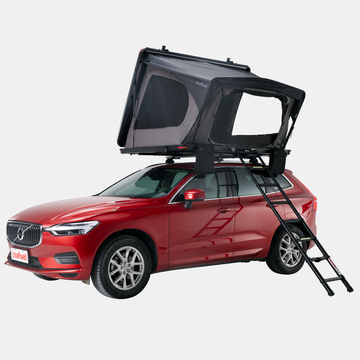Exploring the Wild: The Historical Evolution of Camping from Survival Art to Recreational Diversity-02
by Laine Ye on Dec 28, 2023

The development history and introduction of roof tents
Let me take you back in time and discover the fascinating history of rooftop tents. (One shot is narrated in the center alone)
This story begins in 1928 with a pharmaceutical company owner named Arthur Sherman. On one outing, he took a bulky collapsible canvas shed on wheels but found it to be a pain in the ass to set up. This inspired him to create and decide to design his own RV and its internal supporting facilities. His innovation became the starting point for what was later called the "Father of the RV". Sherman's trailer-type RV cabin was very popular, marking the arrival of the RV era.
In the 1960s, the Type 2 van launched by the German Volkswagen Company marked the fifth generation of RV evolution. It was during this period that the "Trotent" - a revolutionary roof tent - was launched. It not only marked the birth of the roof tent, but was also equipped with a changing room, bringing a new experience to camping.
In 1965, a foldable roof tent named "Bedouin B" appeared on the market, shocking the camping world with its quick erection (only 4 minutes). Then in 1968, Marigold Russell demonstrated the third-generation roof tent called the "Roof Caregiver", which once again improved the convenience and comfort of camping.
However, it wasn't until the 1990s that the paths of RVing and rooftop tents began to diverge. RVs have become more luxurious and expensive, and Napier's first "vehicle tent" provides camping enthusiasts with a more convenient and flexible option. From now on, camping life can go further.
If your life revolves around a 9-to-5 job, weekends become precious time away from your desk and exploring the world. To me, camping is all about escaping the everyday and spending as much quiet time as possible under the starry night sky. However, when life moves at a hectic pace, finding time to plan a camping trip can actually be harder than you think. This is the original intention of the roof tent.
Differences in camping methods
Next, let’s talk about the types of camping. First of all, the first type is:
Backpacking Camping: This style of camping focuses on self-sufficiency, with campers carrying all the essentials on foot, including tents, sleeping bags, food, and water. This approach focuses on exploring and getting closer to nature.
Vehicle Camping: Vehicle camping allows campers to drive to a camping site, often carrying more gear and supplies. This way is more comfortable and suitable for families or people who don’t like hiking.
Glamping: This is a way to combine elements of camping with luxury. Glamping usually offers complete amenities such as comfortable beds, electricity and sometimes even air conditioning and heating.
Survival Camping: Survival camping emphasizes surviving in the wild using minimal resources and equipment. This style of camping focuses on the development of survival skills, such as finding food and making shelter.
Generally speaking, as camping methods diversify, tents and camping equipment continue to develop and improve to adapt to different camping needs and environmental conditions. This reflects people’s continued enthusiasm and innovation for outdoor activities and exploring nature.






